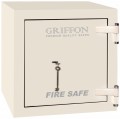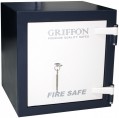Burglary resistance class
A parameter that characterizes the degree of resistance of the safe to burglary - that is, direct damage to the door or wall in order to gain access to the contents.
Safes manufactured in different countries have different certifications for burglary resistance. So, in accordance with the Ukrainian standard DSTU EN 1143-1:2019, there are 13 classes of burglary resistance of safes. The same number of gradations are available in the ECB-S marking, which is assigned to safes by the European Security Systems Association (ESSA). The classification covers not only resistance to damage, but also the tear resistance of an anchored safe, and bracing is required to classify safes weighing less than a one ton (see below). Pull-off resistance is simply determined by the force required to remove it from the mount; this force is indicated in newtons, 10 N corresponds approximately to a force of 1 kg. To assess the resistance to damage there are so-called resistance units (Ru) - breaking time multiplied by the coefficient of resistance of the tool used. For each type of tool, the coefficients are different - for example, from 1 to 5 for a chisel, 5 for an electric drill, etc. For example, if a control sample of a safe of a certain model was cracked by a drill in 4 minutes, then its resistance to cracking is 20 Ru. Note that the check is carried out in two versions - for full and partial access to the contents of the safe; when assigning a class, both results are taken into accou
...nt, they are often written as "partial/full resistance", for example 120/180.
Now there are safes on the market with the following burglary resistance classes: H0 class, Class 0, Class I, Class II< /a>, Class III. Safes with a higher burglar resistance class (Class IV, V class, Class VI, Class VII, Class VIII) are much less common.
Detailed data for each class can be found directly in the regulatory documentation. For example, here are the first three classes:
— H0 class (“below zero”). Minimum burglary resistance class to be certified. Requires a resistance of at least 15 Ru for both access options, and a pull force of at least 50 kN.
- 0 class. Safes with a resistance of at least 30/30 Ru and a pull force of 50 kN or more.
- I class. Models with a resistance of at least 50/30 Ru and a breakout force of 50 kN. The minimum class for safes classified in our catalog as burglar-resistant (see "Product Type").
There are also more burglary-resistant models on the market - up to class VIII.
The burglary resistance class is confirmed by a certificate issued by state bodies for technical regulation and standardization. The validity period of the certificate is limited, and usually it is much less than the time during which this or that model is produced. Therefore, safes are regularly re-certified. For a number of reasons, new results may differ from previous results and correspond to a different resistance class than that recorded in the outdated certificate. Therefore, over time, the class of the same model may change even if the quality of the safes themselves remains unchanged.Number of locking bolts
The number of locking bolts provided in the design of a standard safe lock.
The locking bolt is a working element of the lock, which responds directly to the locking. It is a rod, disk, or other element (usually metal) that fits into a slot in the fixed part of the safe, blocking the opening of the door. The more such elements a safe has, the more reliable the lock and the lower the probability of opening the door by “brute force”.
This parameter in our catalog is indicated for one lock, regardless of their number in a safe. Most often, all safe locks have the same number of bolts.
Now on the market there are locks with the following number of locking bolts:
2,
3,
4,
5,
6 and
more.
External dimensions (HxWxD)
The size of safe regarding its external dimensions. These figures will allow you to estimate how much space the safe takes up and whether it will fit into the intended installation location. Of course, greater capacity implies larger dimensions.
Internal dimensions (HxWxD)
Dimensions of the interior space of the safe. Note that in our catalog this parameter is indicated without a safe-in-safe, ammo compartment (see below) or other additional compartment provided inside.
This parameter directly determines the internal volume (see below). In addition, with the internal dimensions are known, you can determine whether this or that object will fit inside; this is especially important if you plan to use the safe for large items (for example, large-format documents that cannot be folded) — after all, in different models, the dimensions on three sides can vary significantly even with the same capacity.
Weight
The total weight of the empty safe. Unlike many other products, for safes, heavy weight is usually more of an advantage than a disadvantage: the heavier the safe, the more difficult it is to steal it entirely for later opening in a safe place. The only exceptions are portable and automotive models (see "Product Type") — in their case, theft prevention is ensured primarily by fastening, and in the first case, the product, by definition, must be suitable for carrying in hands.

